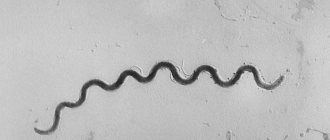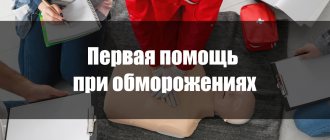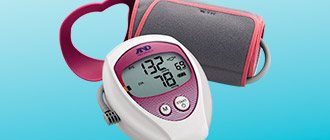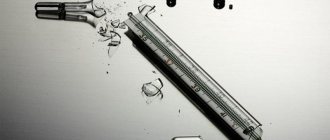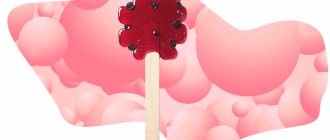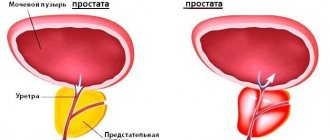If you know exactly the signs of stroke in men, you can avoid serious complications leading to disability and death. A cerebral stroke (CBI) occurs due to impaired blood supply. The attack is facilitated by narrowing of the lumen in the arteries or rupture of blood vessels, resulting in hemorrhage.
Signs of stroke and mini-stroke in men
Precursors of a stroke in a man may include unmotivated weakness, increased fatigue, frequent and persistent headaches that are difficult to relieve with analgesics, dizziness, sudden mood swings, changes in behavior, and nausea not associated with food intake. An approaching attack may be indicated by sudden and causeless increased sweating, numbness of the upper and lower extremities (usually on one side of the body), and slowing of the pulse. Precursors of a stroke are most often short-lived; they can appear several times and go away on their own after some time, which is why the patient does not pay due attention to them.
The first sign of a stroke in men is usually an intense headache. Patients often describe this pain as unbearable, the worst they have ever experienced in their lives. Headache may be accompanied by nausea and vomiting, which does not bring relief.
In the case of thromboembolism of large-caliber cerebral arteries, respiratory failure, sudden loss of consciousness, generalized convulsions, and epileptic seizures are possible. Such symptoms are an unfavorable prognostic sign.
Ischemic stroke
With an ischemic stroke, headache, as a rule, increases gradually, intensifying for no apparent reason. In addition to this, there is usually numbness of the face, dilation of the pupil on the affected side, paresis or paralysis of the limbs, impaired coordination of movements, speech disorders (incorrect use of words, incomprehensible speech), disturbances in the visual analyzer (usually on one side), difficulty swallowing, increased body temperature, agitation, disorientation. On the side opposite to the lesion, muscle atony is observed (manifested in drooping corner of the mouth, drooping upper eyelid, weakness of the limbs).
Thus, in the case of thromboembolism of large-caliber cerebral arteries, respiratory failure, sudden loss of consciousness, generalized convulsions, and epileptic seizures are possible. Such symptoms are an unfavorable prognostic sign.
One of the signs of a stroke is a drooping corner of the mouth.
Hemorrhagic stroke
With a hemorrhagic stroke, an intense headache usually occurs suddenly (the so-called dagger pain). Headache is accompanied by pain in the eyes, a feeling of pulsation in the head, nausea, vomiting, difficulty breathing, palpitations, hemiparesis and hemiplegia, and possible disturbances of consciousness, including stupor and coma. Pendulum-like eye movements, an indifferent gaze, and urinary and fecal incontinence may be noted.
Erased form
Symptoms of stroke in men are rarely atypical, but in patients with diabetes mellitus, a mild form of the disease may occur. In this case, there is no or moderate headache, and there is a general deterioration in health. Despite the mild severity of the symptoms, the disease in this case is no less dangerous than the usual form.
Precursors of a stroke may include unmotivated weakness, increased fatigue, frequent and persistent headaches that are difficult to relieve with analgesics, and dizziness.
Microstroke
The symptoms of a microstroke are generally similar to those of a stroke, but its signs are less pronounced. Often there is only a severe headache that cannot be relieved with conventional painkillers, and/or muscle atony on one side of the body.
Prerequisites
This vascular pathology does not occur suddenly. Even before an acute disruption of the blood supply to the brain, certain symptoms appear. These may indicate the development of a stroke. One such symptom is headache, which cannot be relieved by conventional analgesics, including Paracetamol and Ibuprofen. A man may feel causeless weakness and deterioration in general health. Dizziness occurs up to the point of loss of consciousness . Many of these symptoms are attributed to simple fatigue.
If the patient is in a semi-conscious state, he does not respond to external stimuli. Other long-term signs of pre-stroke in men:
- numbness of the facial muscles and limbs;
- memory impairment;
- movement coordination disorders;
- noise in ears;
- sudden, one-sided weakness in one arm or leg.
How to recognize a stroke
The table shows an algorithm of actions that a patient should be asked to take if a stroke is suspected.
| Action | Signs of a stroke |
| Smile | The smile does not work, or it turns out distorted |
| Raise your hands | The patient cannot raise both arms to the same height |
| Stick out tongue | Tongue deviates from midline |
| Repeat a simple phrase, answer a simple question (for example, what is your name?) | Speech is slurred, “drunk”, the simplest questions cause difficulty in answering |
Forecast
Unfortunately, our country has a very high mortality rate from stroke. A person’s recovery is influenced by a huge number of factors that can affect the patient’s future health in different ways:
- in what area of the brain did the stroke occur?
- extent of damage;
- age;
- decreased cognitive and mental abilities of a person;
- depression.
However, you should never despair and give up: the likelihood of recovery can be increased if you approach it responsibly. If rehabilitation began on time, its system was prepared competently, and the patient himself has not lost his intelligence and is actively committed to the result, he will not have to wait long.
First aid for stroke
The first thing to do at the first signs of a stroke is to call an ambulance. This must be done without waiting for confirmation of your suspicions, since it is extremely important to provide medical assistance before irreversible brain damage develops.
While waiting for an ambulance, it is necessary to sit or lay the patient down, provide access to air (open a window, remove tight clothing), complete rest - the patient should not get up or move suddenly.
If possible, you need to measure your blood pressure and pulse and write down the results, reporting them to the arriving doctor.
If you suspect a stroke, it is important to provide proper first aid
Do not give the patient anything to drink or eat, as this may worsen his condition and cause vomiting.
If the patient has lost consciousness, he should be placed in such a way that the upper part of the body is elevated by about 30 degrees, with his head turned to the side.
The patient should not be left alone until the doctor arrives.
A stroke suffered on the legs (including a micro-stroke) significantly increases the risk of developing a second, more severe attack.
Symptoms of stroke in men are rarely atypical, but in patients with diabetes mellitus, a mild form of the disease may occur.
“BE FAST” test
To make it easier to recognize the signs of apoplexy, doctors came up with the “BE FAST” test. The name itself is an abbreviation that makes it easier to remember the sequence of actions.
FAST Stroke Test
| Decoding | Typical signs |
| B – “balance” | Look how the person moves. Loss of balance is an alarming symptom. |
| E – “eyes” | Ask what the victim sees. Ask to alternately close both eyes. One- and two-sided blindness is typical for a stroke. |
| F – “face” | Let the person smile: an asymmetrical, crooked smile is a sign of paralysis. Verification option - please show your tongue. It will be crooked. |
| A – “arms” | Ask the victim to raise both hands. The victim will be able to lift only one, the second will be lower or quickly fall. Option – shake the patient’s hands. One of them will “respond” weaker. |
| S – “speech” | Find out how the person is feeling. Speech disturbances are characteristic of acute cerebral circulation. |
| T – “time” | The presence of one or more positive tests is a reason to urgently call an ambulance. Temporary improvement in condition, a person’s denial of violations is not a reason to doubt. When describing the patient’s condition, be sure to inform the dispatcher of the test results. |
What is a stroke
A stroke is an acute disturbance of cerebral circulation due to thrombosis, embolism, prolonged spasm or sudden rupture of cerebral blood vessels. In this case, patients experience neurological disorders caused by acute hypoxia of one or another part of the brain, and in the case of a hemorrhagic stroke, additional damage due to the shedding of blood.
This is one of the widespread vascular diseases; it is one of the main causes of disability and mortality. The incidence is associated with age - the age group over 60 years of age is most vulnerable to stroke, although doctors all over the world note an increase in the incidence in patients 30-35 years old. The incidence of strokes in men after 40 and before 50 years of age is 4 times higher than in women, but after 50 years of age the incidence becomes the same in both sexes.
general information
Stroke is a group of diseases characterized by disturbances in brain activity or loss of brain functions. Abbreviated as ONMK. Symptoms develop suddenly and very quickly (within minutes) and last a day or more. During a stroke, there is a severe disruption of blood supply to the brain with rapidly developing focal or cerebral neurological symptoms. The wall of the vessel ruptures (or becomes blocked), and brain cells begin to die, which cannot be restored.
Stroke is divided into 2 main types: ischemic (the most common) and hemorrhagic. In the first case, due to thrombosis, too little blood enters the brain or the blood supply stops completely. With hemorrhagic, the walls of blood vessels are damaged, a hematoma is formed and interferes with the normal functioning of the brain.
Forms of the disease
The main forms of stroke are ischemic and hemorrhagic. Hemorrhagic stroke usually has a more severe course, but has a better prognosis due to a more vivid clinical picture, which prompts prompt and timely seeking medical help and avoiding the development of severe consequences.
Depending on the location of the source of ischemia, stroke is divided into right- and left-sided. With a left-sided form of the disease, the right side of the body is affected, and with a right-sided stroke, the left side is affected.
According to the severity, a stroke can be mild, moderate, severe (extensive) or micro-stroke. A major stroke is caused by damage to a large cerebral artery, a micro-stroke is caused by a blockage of a small-caliber artery.
The first thing to do at the first signs of a stroke is to call an ambulance. You need to do this without waiting for your suspicions to be confirmed.
What are the causes and risk factors for stroke?
The causes of stroke include: damage to the blood vessels of the brain against the background of progressive cardiovascular pathology (heart rhythm disturbances, atherosclerotic damage to blood vessels, arterial hypertension, myocardial infarction), endocrine disorders (diabetes mellitus), severe somatic or infectious diseases, as well as long-term high blood pressure of various origins.
Risk factors: old age, exposure to stress, excessive physical activity, smoking, alcohol abuse, excess body weight, unbalanced diet, uncontrolled use of medications. Smoking is particularly dangerous, as it has an extremely adverse effect on the condition of blood vessels.
Features of damage to individual parts of the brain
The symptoms of a stroke can sometimes indicate the location of the lesion. After all, different parts of the brain are responsible for different functions.
| Localization of infarction/hemorrhage | Characteristic symptoms |
| Frontal lobe |
|
| Parietal lobe |
|
| Temporal lobe |
|
| Occipital lobe |
|
| Cerebellum |
|
| Brain stem |
|
Treatment
Patients are prescribed bed rest, the duration of which, depending on the condition, can range from several days to 4-6 weeks. For prolonged bed rest, anticoagulant therapy is prescribed.
In case of cerebral edema, hyperventilation of the lungs and surgical intervention to decompress the brain are performed.
Stroke requires hospitalization
Diuretic drugs, analgesics, antiplatelet agents, anticonvulsants, drugs that improve cerebral circulation, and barbiturates are prescribed. For high blood pressure - antihypertensive drugs.
Surgical treatment is indicated for signs of compression of the brain, a high risk of a recurrent attack, no effect from anti-edematous therapy, and some other conditions.
Rehabilitation
How to avoid adverse consequences? To do this, restoration of lost or impaired abilities must begin immediately after the patient’s condition has stabilized. Rehabilitation activities begin with passive gymnastics, then gradually increase the complexity of the exercises performed.
Patients experience neurological disorders caused by acute hypoxia of one or another part of the brain, and in the case of a hemorrhagic stroke, additional damage due to bleeding.
It may be necessary to work with a speech therapist, a psychologist, physical therapy, massage, therapeutic exercises, and sanatorium treatment are indicated.
Consequences
Since nervous tissue is incapable of regeneration, dead neurocytes are not restored, which is why the functions for which they were responsible are disrupted. Their work is partially taken over by the surrounding tissues, but it is impossible to completely return the former healthy state of the brain. A man remains with the consequences of a stroke for the rest of his life:
- paresis;
- paresthesias;
- dysarthria;
- loss of sensitivity in some areas of the skin;
- blurred vision;
- aphasia (impairment of already formed speech);
- impaired concentration;
- frequent headaches.
Prevention
To prevent the development of a recurrent attack, you should strictly follow all the recommendations of your doctor, undergo supportive therapy, and monitor your blood pressure. All people over 30 years of age are recommended to check the concentration of cholesterol in their blood at least once every five years; after 50 years of age, this test is recommended to be carried out annually.
It is necessary to give up bad habits, lead an active lifestyle, spend more time outdoors, and adhere to the principles of proper nutrition. Adequate rest, in particular, adequate sleep at night (at least 7 hours of uninterrupted sleep) is extremely important.




